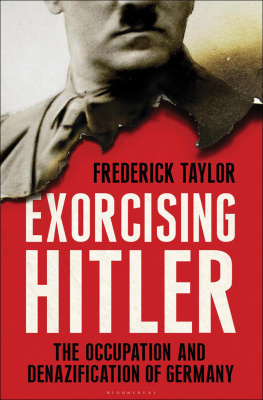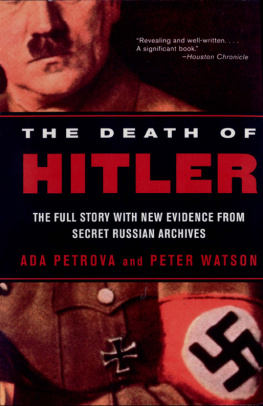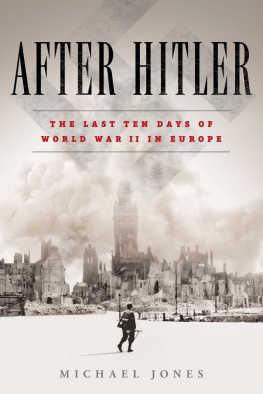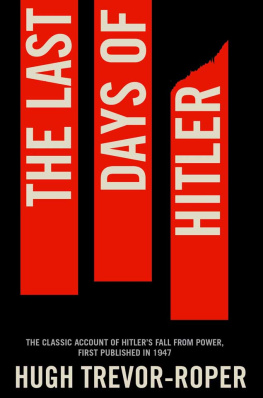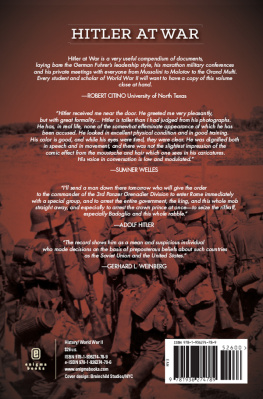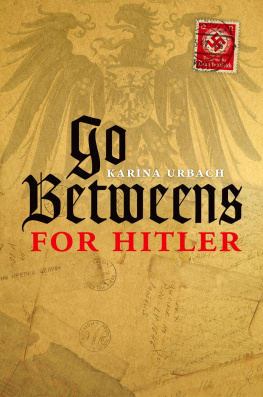Also by Michael Jones
The Kings Mother
Bosworth 1485: Psychology of a Battle
Agincourt 1415: A Battlefield Guide
Stalingrad: How the Red Army Triumphed
Leningrad: State of Siege
The Retreat: Hitlers First Defeat
Total War: From Stalingrad to Berlin
The Kings Grave: The Search for Richard III
AFTER HITLER
The Last Days of the Second World War in Europe
Michael Jones

www.johnmurray.co.uk
First published in Great Britain in 2015 by John Murray (Publishers)
An Hachette UK company
Copyright Michael Jones 2015
The right of Michael Jones to be identified as the Author of the Work has been asserted by him in accordance with the Copyright, Designs and Patents Act 1988.
Maps drawn by Rodney Paull
All rights reserved.
No part of this publication may be reproduced, stored in a retrieval system, or transmitted, in any form or by any means without the prior written permission of the publisher.
A CIP catalogue record for this title is available from the British Library
Ebook ISBN 978-1-84854-497-0
John Murray (Publishers)
338 Euston Road
London NW1 3BH
www.johnmurray.co.uk
To all those from East and West
who fought to rid Europe of fascism
Contents
List of Illustrations
. The spell breaks: the Nazi eagle and swastika above the damaged grandstand of their rally site at Nuremberg
. East meets West: Lieutenants William Robertson and Alexander Sylvashko embrace at Torgau on the Elbe (25 April 1945)
. US infantrymen move down a street in Waldenburg, south central Germany, April 1945
. Berlin falls to the Red Army: Marshal Georgi Zhukov on the steps of the Reichstag, 2 May
. British tanks race towards Lbeck, 2 May
. The horror: sign erected by British forces outside Bergen-Belsen concentration camp, May 1945
. The British arrive at Hamburg: a Cromwell tank guards the bridge over the Elbe
. German soldiers some using horse-drawn transport make their way towards British forces to surrender
. British and Russian troops meet at Wismar, 3 May
. A Russian tanker and British sapper drink to victory
. Montys triumph: the British field marshal receives the German delegation at Lneburg Heath, 3 May
. A day later the formal surrender of Denmark, Holland and north-western Germany is signed in Montgomerys tent
. The American field command seated (left to right) are Generals William Simpson, George Patton, Carl Spaatz, Dwight Eisenhower, Omar Bradley, Courtney Hodges and Leonard Gerow. Standing (centre) is Eisenhowers chief of staff, General Walter Bedell Smith
. High-ranking American and Russian officers meet on the Elbe, 5 May (from the Soviet 3rd Guards Tank Corps and the US Third Army)
. Confronting the truth: a German woman walks past bodies of murdered slave workers exhumed by US troops near Nammering, Germany
. Prisoners of Mauthausen concentration camp (Austria) liberated by US soldiers on 5 May
. The anguish: refugees on the road trying to return home
. Displaced Persons one of the great humanitarian challenges faced by the Allies
. Calling all Czechs! Barricades go up in Prague at the beginning of the uprising, 5 May
. US troops enter western Czechoslovakia, 6 May
. Operation Manna: loading supplies to be airdropped to the starving Dutch population
. Unlikely rescuers: troops from the 1st Division Russian Liberation Army (Vlasov Army) arrive outside the Militia HQ, Prague, 6 May
. Field Marshal Montgomery meets his Russian counterpart, Field Marshal Rokossovsky, at Wismar on the Baltic
. General Alfred Jodl signs the first unconditional surrender at SHAEF headquarters, Rheims, 7 May
. False alarm: a special edition of Stars and Stripes prematurely announces Germany Quits! on 7 May
. VE-Day in London, 8 May: a huge crowd gathers at Whitehall to hear Churchills speech
. The German war is at an end: Churchill broadcasts to the nation
. The day of death: SS units fight for the centre of Prague with Czech insurgents, 8 May
. The second signing at Karlshorst: the German delegation now headed by Field Marshal Keitel
.The Allied delegation now headed by Russias supreme commander, Georgi Zhukov
.Russian troops liberate Prague
.VE-Day in Moscow, 9 May
. The celebratory fireworks that night
Illustration Credits
Imperial War Museums: 1 above/IWM CL3092, 3 above/IWM BU4972, 3 below/IWM BU6955, 4 above/IWM BU5077, 4 below/IWM CL2538, 5 above/IWM BU5230, 5 below/IWM BU5238, 6 above/IWM BU5145, 6 below/IWM BU5207, 12 above left/IWM BU5523, 12 above right/IWM EA65715, 12 below/IWM EA65948, 13 above/IWM D24586, 13 below/IWM H41846, 14 below/IWM FRA203385. National Archives and Records Administration (NARA): 1 below/NARA 111-SC-204516, 2 above/NARA 111-SC-205778, 7 above/NARA 280-YE-182, 8 above/NARA 111-SC-264895. Prague Military Institute: 10, 11. RIA Novosti: 2 below/RIA Novosti 608394, 7 below/RIA Novosti 362876, 8 below/RIA Novosti 369161, 9 above/RIA Novosti 608790, 9 below/RIA Novosti 355, 14 above/RIA Novosti 677390, 15 above/RIA Novosti 574539, 15 below/RIA Novosti 881134, 16 above/RIA Novosti 594370, 16 below/RIA Novosti 583984.
Every reasonable effort has been made to trace copyright holders, but if there are any errors or omissions, John Murray will be pleased to insert the appropriate acknowledgements in any subsequent printings or editions.
List of Maps
. General situation map showing Allied advance to May 1945
. The British advance to the Baltic, 2 May 1945
. The Prague uprising, 59 May 1945
Preface
MAY 2015 WILL be the seventieth anniversary of VE-Day in Europe. For many, in the Allied armed forces and among the civilians who supported the war effort, it will be a last opportunity to connect with a vitally important achievement the overthrow of Hitler and the Nazi regime. We remember those who sacrificed their lives so that we might see this day. All of us are in their debt.
This book tells the story of the last ten days of the war, from the death of Hitler on 30 April to the celebration of VE-Day in Moscow on 9 May, a day after it is held in the West.
In its structure, it follows a countdown formula from day to day but within this framework it also takes a thematic approach, bringing out the complex international politics and diplomacy that underlay these military events. It also addresses a wider concern the humanitarian catastrophe that was engulfing Europe and the psychological impact this had on those caught up in it.
Its central aim is to show why we celebrate two VE-Days 8 May in the West, 9 May in the East (although the Channel Islands also celebrate their liberation on 9 May): how this came about and what its real significance is. These separate days tell a story of the common cause between allies, but also of the divisions that nearly caused a rift between them in the days after Hitlers death. It was a crisis largely hidden from public view and in the event it was successfully mastered. All those involved in the behind-the-scenes diplomacy deserve credit for that.
I have tried to present a view that is fair to all the members of the Grand Alliance, and in particular the Soviet Union whose motives in May 1945 (and indeed throughout the war) were sometimes viewed with considerable suspicion in the West recognising its major contribution to the victory against Nazi Germany and that it had legitimate concerns of its own. In a final reckoning, we will never know whether the descent into the Cold War was inevitable. I look at the pernicious influence of the administration of Hitlers successor, Admiral Dnitz, whose shadowy role in the days after the Fhrers death is often underestimated and the fears of both sides as the post-war map of Europe began to unfold. In such circumstances, I believe it was a real achievement that the Alliance held firm at the wars very end.





